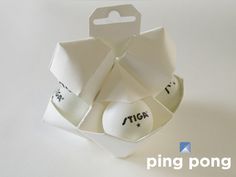One way to package ping pong balls is to create a carrier for them. This can be made of paper and features a designated hole for hanging. You can also make a carrier out of glue and ping pong balls. Another option is to use elephant hide paper. This is a durable and lightweight option that is also space-efficient. It can be folded and glued in three spots and tabbed in two others.
Ping Pong balls are made of celluloid
Celluloid has been the standard material for Ping Pong balls for over a century. However, this material is flammable, which can make it difficult to store and ship. A new poly-plastic ball is approved by the International Table Tennis Federation (ITTF). It offers many of the same benefits as celluloid but is more environmentally friendly and safer to transport. Although celluloid is not widely available, celluloid balls are still sold for recreational and competitive purposes. The future of manufacturing celluloid balls depends on the demand and availability of the material.
A celluloid is a thermoplastic polymer composed of nitrocellulose and camphor. Before ABS was introduced in the 1970s, celluloid balls were the standard for table tennis. However, the toxicity of celluloid forced the introduction of plastic ping pong balls. In 2014, the International Table Tennis Federation (ITTF) decided to put celluloid balls into history. This has led to the rise of poly-plastic balls, but celluloid balls are still available for recreational use and local competitions.

They are inflated with air
Traditionally, Ping Pong Ball packaging is inflated using air. The product needs a strong, sturdy container that can handle the pressure. Otherwise, the pressure could lead to the leakage of the product. In some cases, the packaging is simply ineffective, and it may not keep the product safe. However, there are ways to prevent this from happening. One of the most common ways is to use a drinking straw to blow air between the balls. This way, they will bounce back.
The air pressure in a ping pong ball is based on the weight of a column of air that is pushing down on a specific area. The column of air is constantly “pushing” objects on Earth. When this column of air moves faster, it lowers the pressure on the object. As a result, the ping pong ball is more buoyant than the water that it contains.
They are made of ABS plastic
ABS is one of the most common plastics used to manufacture ping pong balls. They are also easier to track. Joola 3-Star Training Balls are orange in color and made of ABS plastic. They are durable enough to be used on hard surfaces. Joola is a trusted brand for ping pong balls and is a go-to provider for major events. If you’re looking for quality, Joola has a selection of Ping Pong Balls that will suit your needs.
ABS is a widely used plastic material and is safe to use in large quantities. Other common uses of ABS include pipes, Lego, and 3D printer filament. You can see an example of how ABS plastic is used in the production of a ping pong ball in a video produced by World Table Tennis. Since plastic ping pong balls are a relatively cheap and easily available option, manufacturers are now using this material in their ping pong ball packaging.
They are made of sponge foam composite
Most ping pong balls are composed of celluloid. Celluloid is an inorganic material that was first used to manufacture ping pong balls. It is durable, good in all respects, and also flammable. However, in the past few years, new material has emerged that has changed the game of table tennis forever: Acrylonitrile Butadiene Styrene (ABS). This thermoplastic polymer has become the “new generation” of table tennis balls.
Celluloid balls were once made of celluloid, a material commonly used to create jewelry and toys. However, they are no longer manufactured as much as they used to be. Plastic ping pong balls are a more environmentally friendly alternative, as they don’t produce as much noise as celluloid. They are also more durable and last longer than celluloid balls. While celluloid balls have many benefits, sponge foam composite balls have their drawbacks as well.
They are packaged automatically
Before the ping pong balls are packaged for sale, they must first be shaped. Usually, this requires two plastic sheets. Each sheet must be weighed carefully to determine its weight. After weighing, a copper head is used to press the sheet into shape. This is followed by a process in which hot water is dripped on the plastic sheet to prevent cracking. The ball is then placed into a huge warehouse and stored at temperatures between 113 degrees Fahrenheit and 122 degrees Fahrenheit for up to 15 days.
Once the ping pong balls are manufactured, the printing process is fully automated. Then, the balls are packed and shipped. Ping pong balls for the competition are positively quality, professionally made balls with adequate bounce and durability. The ITTF-approved balls should be durable and sufficiently bouncy. Recreational ping pong balls, on the other hand, are lightweight and can be used for games at home or a nightclub.
For more details visit this website: https://customboxesmarket.com/custom-retail-boxes/









